Throughout 2017’s Maha Music Festival, artists praised the ninth-annual event as an unexpected surprise.
Priests frontwoman Katie Alice Greer noted and applauded the fact that people in Omaha are driven to bring big-name and up-and-coming talents to the city. Victoria Ruiz of Rhode Island’s Downtown Boys defined her chance to play at such a “cool festival” as catharsis.
And perhaps the most telling, from Run The Jewels emcee El-P: “Who knew Omaha was so lit?”
Really, this praise only affirmed what Nebraska music fans already know. As has become the norm at Maha Music Festival, music, comedy and education exist harmoniously, while hoards of festival-goers ravage the line of food trucks, attendees take rides on the Werner Enterprises ferris wheel and kids blow bubbles near the Community Village tents. It all entertains without a hitch or a conflict. It’s symbolic of the hometown cultivation that was Maha 2017, with nearly 400 volunteers and dozens of local nonprofits making everything from the Community Village to the festival’s stellar lineup possible.
Last year in our Maha coverage, we commended the festival for running as smoothly as ever. But without the early morning rains that forced abbreviated sets and altered the 2016 festival’s lineup, the “smoothly-as-ever” award would have to be handed over to Maha’s 2017 edition. The festival started right on time, and not once did it divert from the pocket-sized schedules handed out at the gates.
Those same pocket schedules listed Maha’s most musically diverse lineup yet, with fiery up-and-coming punk rockers, renowned and experienced indie rock bands, pulsating dance music, and one of the hottest hip-hop acts on the planet. From The Hottman Sisters to Run The Jewels, each transition between bands seemed logical, like a natural continuation of the act before. The New Pornographers’ infectious power pop merged right into Built To Spill’s tested indie rock, and Belle and Sebastian’s electronic-tinged pop segued effortlessly into the party that would follow with Sleigh Bells, The Faint and Run The Jewels.
—Sam Crisler
Read on for our act-by-act photo and written coverage.
The Hottman Sisters
Omaha indie pop trio The Hottman Sisters kicked off Maha, playing for a strong early festival crowd. They thanked the audience and charged straight into an onslaught of droning guitar and crashing cymbals, which then subsided into “My War” from the band’s debut EP This Too.
Heather Hottman lined up stage right behind her synthesizer, and her sister, Jessica, stood stage left with a sunburst Strat in hand. Ed Getzlaff backed them up with a drumming style that avoided flashiness, but it didn’t need to. The band’s Fleetwood Mac-inspired pop songs were best served by the sisters’ trading the audience’s attention from song to song. And that’s more or less how the band’s half-hour set played out.
The sisters swapped lead singing duties on songs like “Who I Was” and “Teleprompter King,” both adding healthy doses of vocal interplay to each cut. Lush harmonies dominated the set, at times matching the drums and low-end guitar progressions.
The Hottman Sisters’ constant touring seems to have earned the band a thick skin because, the band still appeared confident opening the fest on the OMNE Partners stage. Heather headbanged and pounded her synths while Jessica nailed tricky guitar licks during “My War.” Credit them with shaking the crowd’s early-afternoon cobwebs by leading the festival-goers in clapping and singing along to the “Who I Was” hook. The Hottman Sisters sent this year’s festival into a comfortable groove that only built as the day went on.
—Sam Crisler
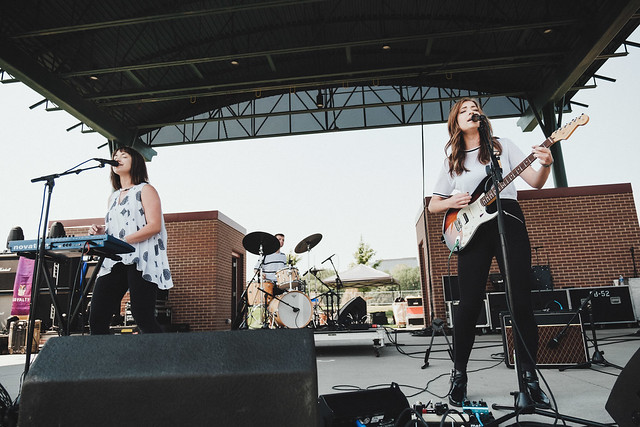
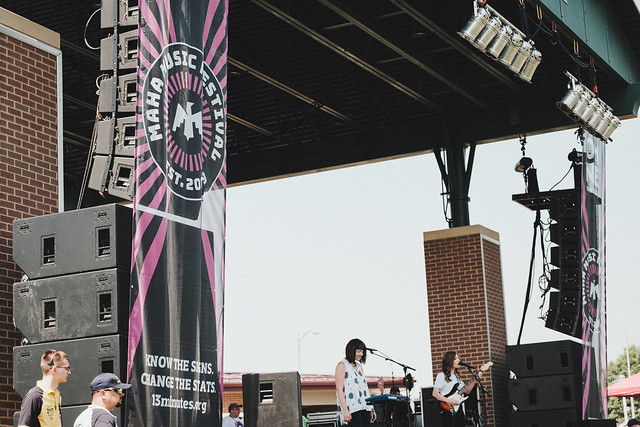
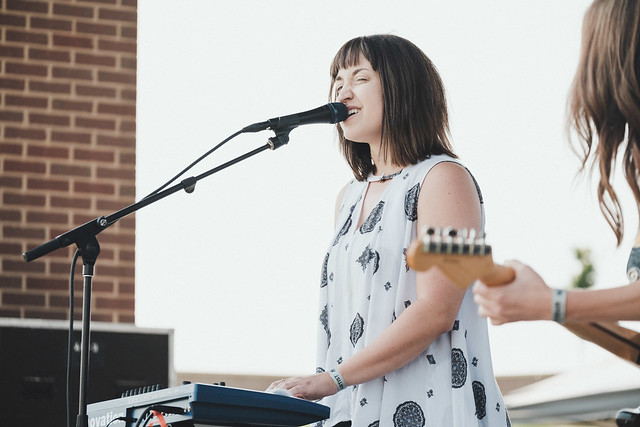
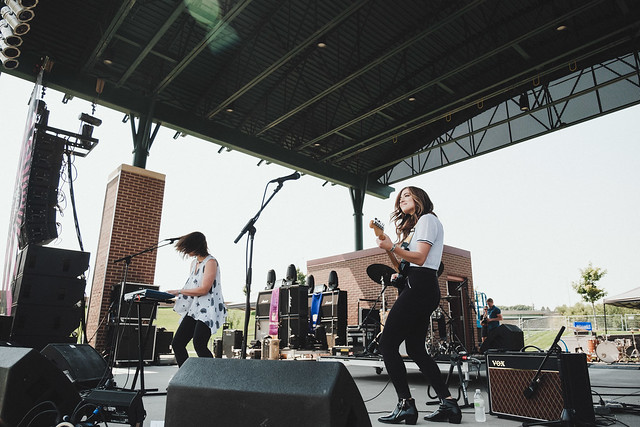
photos by Peter Barnes
Downtown Boys
If The Hottman Sisters introduced a steady pace to Maha, Downtown Boys took it, hit the gas pedal and drove it up to top speed.
The Providence five-piece burned through twelve songs of blistering post-punk, complete with thunderous saxophone, jagged guitar riffing and frontwoman Victoria Ruiz’ serious but eccentric vocal delivery.
Downtown Boys were a late addition to Maha’s lineup after Surfer Blood dropped their slot, but in light of the recent events in Charlottesville, Virginia, Downtown Boys’ off-kilter, socio-political brand of punk felt appropriate. Through the set, Ruiz, wearing a red floral dress and a flower crown, shouted lyrics condemning fascism and the patriarchy and challenging employment discrimination against black and Hispanic folks. And sitting sidestage, Priests’ frontwoman Katie Alice Greer mouthed the words along with Ruiz
Ruiz spent much of her time near the edge of the stage, as if her goal was to drive her message as deeply as possible into the growing Maha crowd. When Ruiz backed away from the Weitz Stage’s ten-foot drop-off during “Wave Of History,” she took in her band’s pummeling drums and rugged baselines and swayed like a hula dancer for a moment. Then returned to stomping around the stage, roaring through clenched teeth.
Near the middle of the set, Ruiz mentioned the fact that an alt-right rally was held on Saturday in Boston, just an hour from Providence. But she thanked Maha’s organizers for the opportunity to perform and avoid America’s political unrest for a moment.
Ruiz’ veins popped and she lost her breath during “Somos Chulas (No Somos Pendejas).”
“Hopefully this moment can be a moment of catharsis,” Ruiz said. Catharsis it seemed to be.
—Sam Crisler
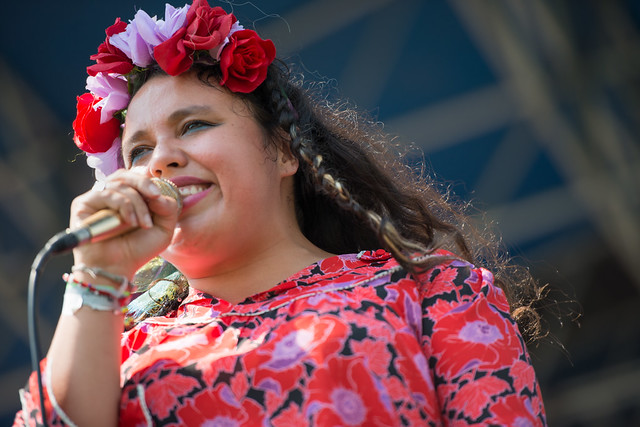
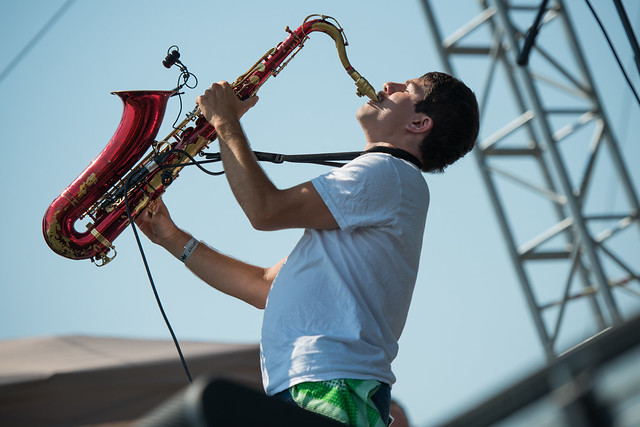
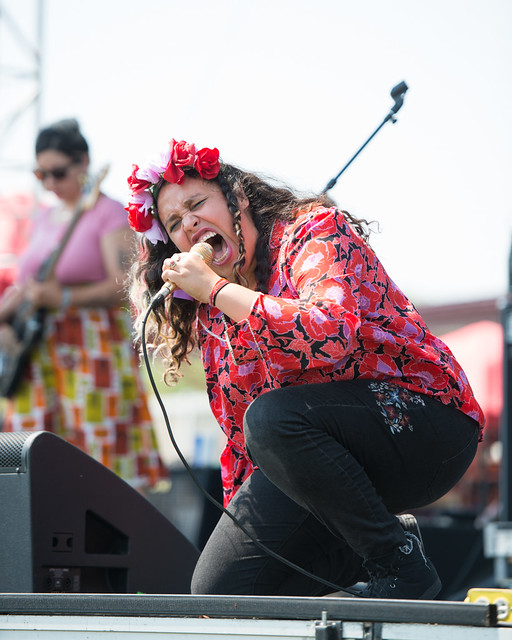
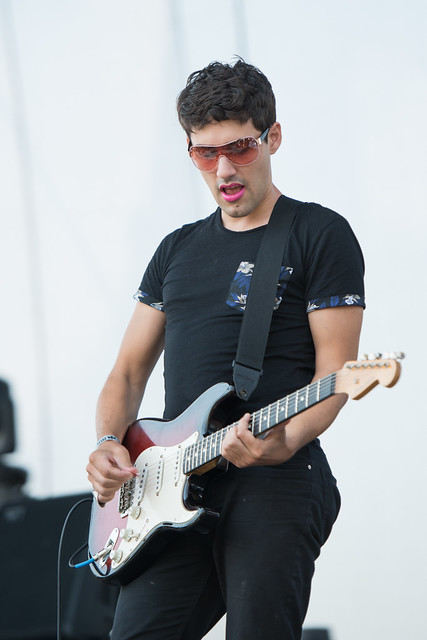
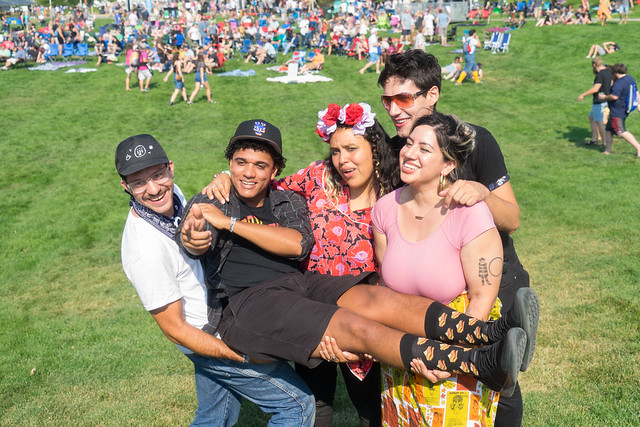
photos by Harrison Martin
High Up
There’s a wild, almost visible magnetism about Christine Fink. Even before her set, fronting the funk/soul/punk-inspired High Up, Fink’s presence near the mic seemed to pull the crowd closer—first from the Weitz stage where Downtown Boys had just brought us all into 3017, and then right up to her feet, the audience hunched and leaning forward on the awkward incline before the Omne stage, achilles heels strained tight above Converse shoes. The draw comes in part from Fink’s roving stage presence, her running here and there or at one point falling to the floor, which got someone in the audience shouting “James Brown.” But in the main her effect comes through her vocals. Fink’s is a high, classical voice with wide range and a foundational sense of power. There’s a dryness to it, a volume and raw clarity that melded with the atmosphere during the third act of the afternoon: Maha maps fanning sun-beat faces, the sky so hot and clear as to be white.
With an accompaniment of horns and backing vocals, Josh Soto on a rollicking, syrupy bass and Todd Fink on guitar and keys, High Up played a sharp ten-song set, taking listeners from dreamy croonscapes with songs like “You Can’t Give Up On Me,” to the groovey big, band feel of songs like “Your System Failed You” and “Two Weeks,” High Up’s closer before Omaha Girls Rock later took the stage.
This year the two acts from non-profit Omaha Girls Rock were Smoking Mirrors and The Clearance Section. The bands, all made up of young women, used some of High Up’s gear after their set, and each performed one song: Smoking Mirrors’ a rocking assertion of self-reliance in the face of pain, and The Clearance Section’s an encouraging note of acceptance. “Be you. Be happy,” they sang.
It was a fitting combination Saturday afternoon, having the non-profit’s talented young performers follow High Up’s show. It’s difficult to picture more impressive artistic models than the Finks and the other members of High Up, who’d just lifted a few hearts themselves.
—Nathan Sindelar
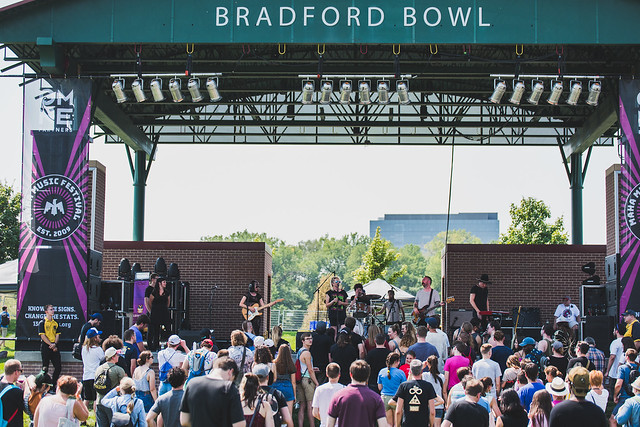
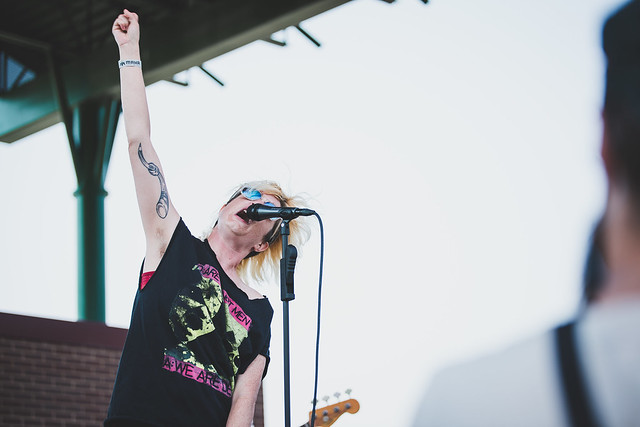
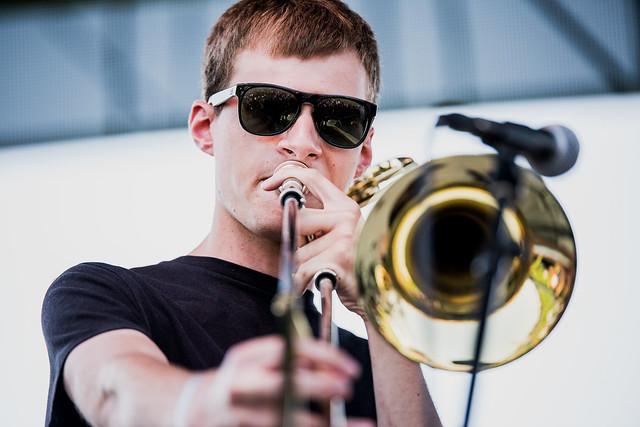
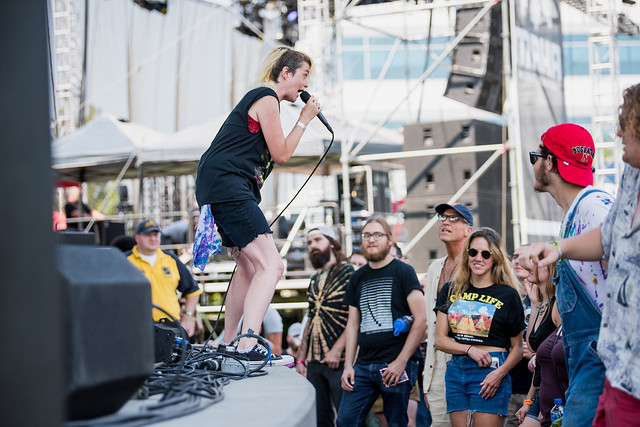

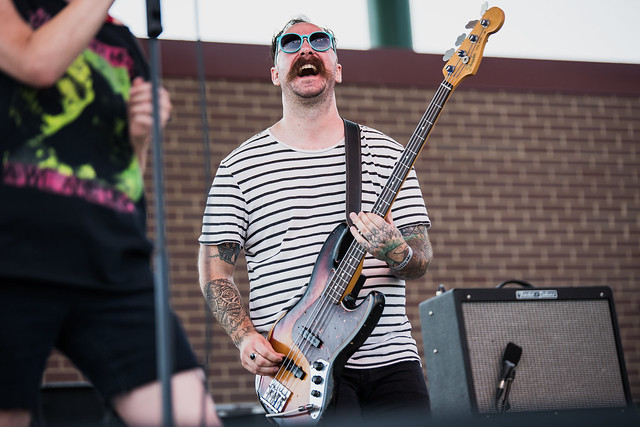
photos by Emma Petersen
Torres
Torres’ is a frustrating act, but only in so far as frontwoman and song-writer Mackenzie Scott won’t let you off her long, slow hook—synth and pedal-heavy, staticky, damp. Perhaps the best way to say it is Scott’s mechanized stage presence, and her hesitance to release audiences from the unrelenting, industrial climb of her songs, leaves one feeling stopped up, congested in the heart.
One wants a release after several minutes of the slow burning, ambient build-up. One wants the song to break apart and speed up, to explode in a few sharp chords or a tangible riff if only for a moment. It was clear through the whole set that audience members wanted to dance. The shoulders start to sway, heads bobbing a little and stopping, feet beginning to stomp with the electric drum-kick. All the sonic ingredients were present, but held back. A drop never came, no bridge to faster, dancier waters. And Scott knows it. Even in her hyper-controlled posture, she occasionally let out a shift of hips, a little shimmy here and there to point at and tease the possibility of catharsis lurking below her songs’ surface.
The set was comprised of tracks from Scott’s three albums, Torres, Sprinter, and the yet-unreleased Three Futures, which comes out this September. Some songs (“Sprinter” comes to mind) do move with more urgency, but on the whole the effect of the show was almost paralyzing, smaller melodies winking at the audience as they trifled above or below the wall-of-sound bass and drums. Even the Maha bannisters draped down the speakers of the Weitz stage, rippling in a breeze and then going still. We wanted a release, but in retrospect one gathers a sense that these songs, and the set as a whole, are improved for their demanding restraint, that Scott’s music wouldn’t be so affecting were it to give us what we wanted.
Plus, it left everyone with stores of potential energy for the acts to follow.
—Nathan Sindelar


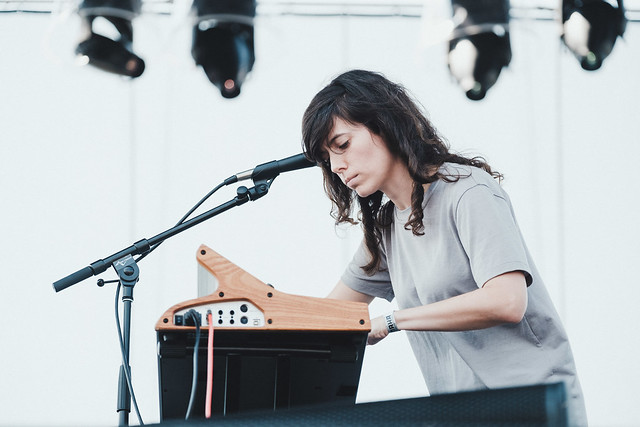
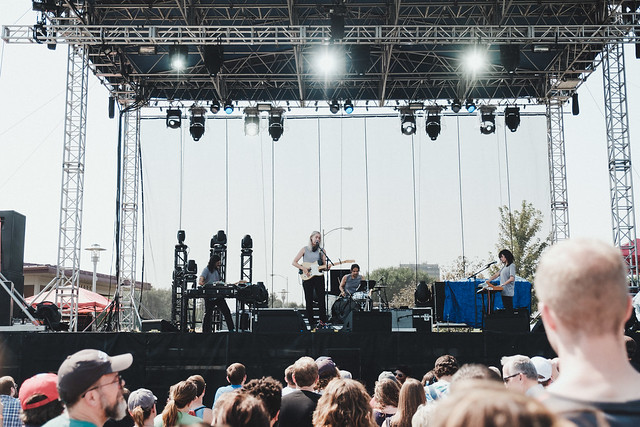
photos by Peter Barnes
Priests
If there were any two similar-sounding Maha bands, they were the two groups of punks in Priests and Downtown Boys blasting through afternoon sets. Priests shared Downtown Boys’ affinity for angular, noisy guitars and political, pissed-off yelling at breakneck speed. Like Downtown Boys’ Ruiz, Priests’ Greer commanded the stage, tramping around and hip-thrusting to the rhythm in her pink tutu and lace-up cowgirl boots. She sang with a forceful, soul-tinged delivery that blended Amy Winehouse and Corin Tucker along with a mission to expose politicians’ and government’s hypocrisy. “You are just a cog in the machine and I am a wet dream soft and mean” she sang on “Pink White House” from Priests’ latest LP Nothing Feels Natural.
While Priests and Downtown Boys had their similarities, Priests’ found their distinct sound in frequent instrumental breaks, where guitarist GL Jaguar would either thrash through scorching solos on his gold SG, or would rock back and forth to relaxed guitar lines. Jaguar’s discordant guitar work somehow weaved into bassist Taylor Mulitz’ own rigid thumping, despite chord progressions that intentionally never lined up.
During these breaks, Greer would stare out into the crowd, sneering with her mouth hanging half-open, like she wanted to see if anyone would come up on stage to try and stop her. As Priests’ tore through the Fugazi-esque “And Breeding,” Greer left any remaining anger on stage, shouting the lyrics: “Fucking and breeding, fucking and breeding.” The crowd shouted back; Greer had accomplished her mission.
—Sam Crisler
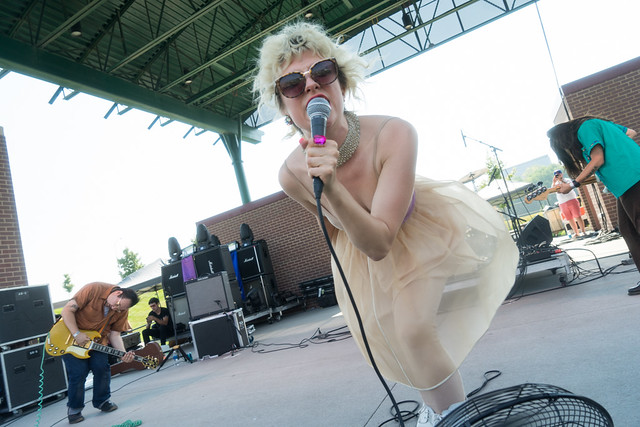
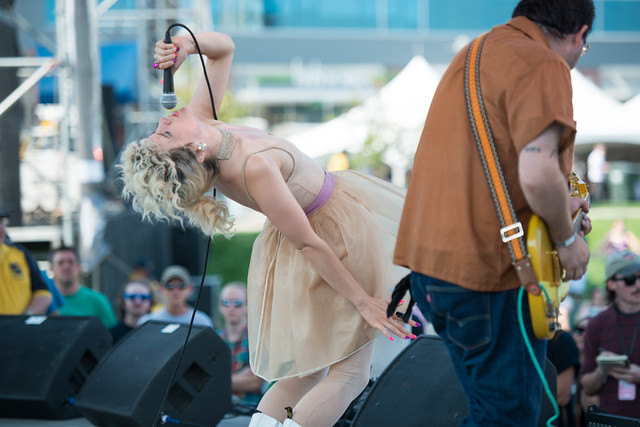
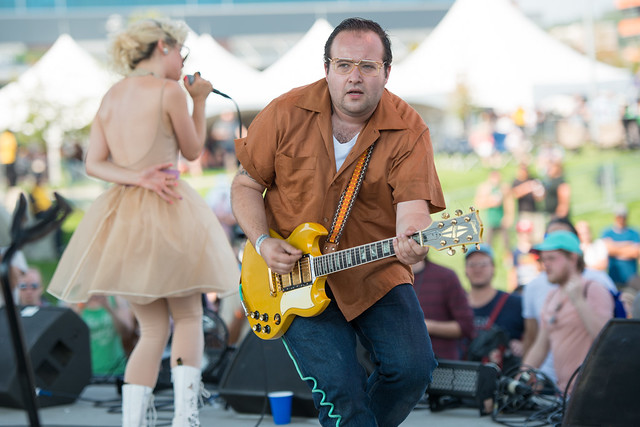
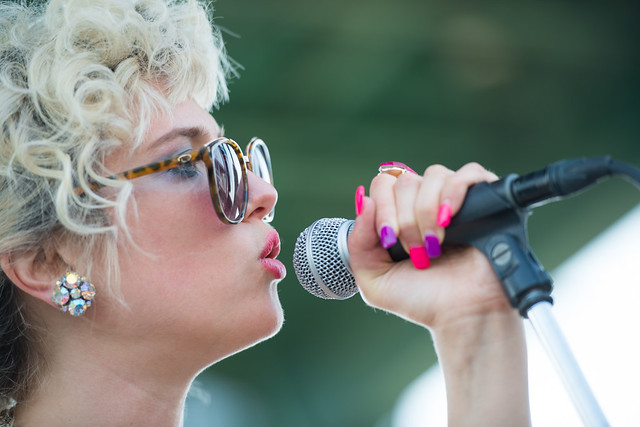
photos by Harrison Martin
The New Pornographers
Up to The New Pornographers’ late afternoon performance, politically charged sets from Downtown Boys, and Priests formed an air at Maha of social consciousness. Though The New Pornographers’ power pop doesn’t exactly lend itself to spurring political action, the band took the Weitz Stage as a recording bellowed “People, we finally have to fight.” The Vancouver collective then fought with a set chock full of hits, dense instrumentation from violin, two keyboards and two guitars and the band’s distinctive hooks.
Oh god, the hooks. With two vocalists in Kathryn Calder and Simi Stone backing him up, frontman Carl Newman belted catchy chorus after catchy chorus on hits like “Moves” and “Brill Bruisers.” Like The Hottman Sisters who played a few hours before, Calder’s and Stone’s vocal flourishes and harmonies prevailed over all instruments — even the deafening bass drum. “Mass Romantic” had audience members who didn’t know the lyrics bobbing along to Joe Seiders’ drum beats, and “All The Old Showstoppers” heard the crowd singing the harmonies right back to the band. Combined with staccato keys and the occasional guitar solo, the instrumentation and vocal interplay fused into succinctly written pop songs.
If there was a downside to The New Pornographers’ set, though, it was the absence of crowd interaction and stage banter among the seven multi-talented members. Newman occasionally offered a deadpan quip calling the next song the band’s best song, but The New Pornographers seemed to prefer to stick to what they do best — forcing songs into listeners’ heads for good.
—Sam Crisler

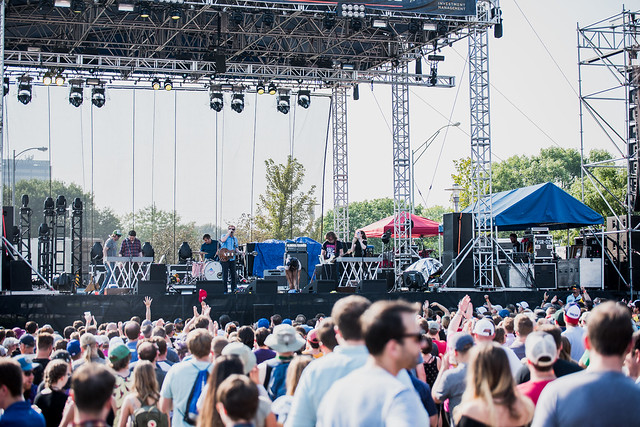
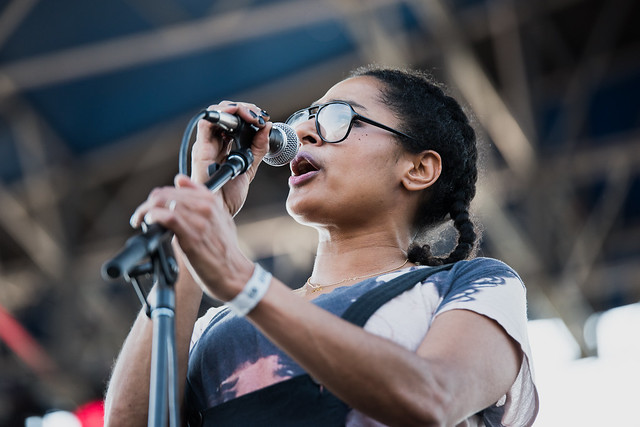
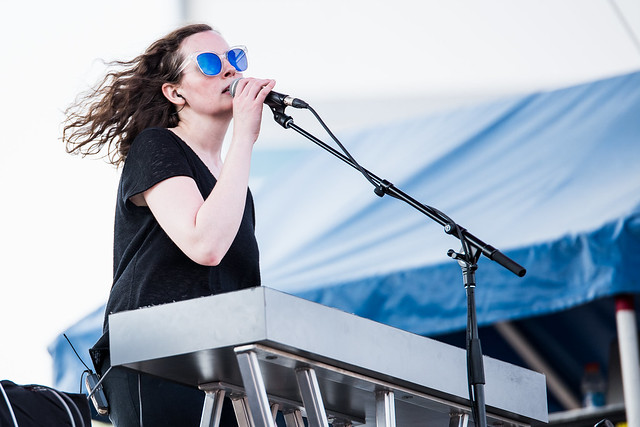

photos by Emma Petersen
Built To Spill
Built to Spill took the Omne stage early Saturday evening to play the entirety of their classic 1999 album, Keep It Like a Secret, but they did so a little lighter than the last time they came through Nebraska. The Boise, Idaho indie group has been performing since the early nineties and in most cases with five members (three of whom on guitar), but on Saturday there were only three.
The show was a tall order from the outset. By its nature, Built to Spill’s is tapestried rock music, layered with alternating and competing riffs and solos, which in most cases evolve and morph over the course of the band’s quite long songs. Doug Martsch, frontman from the time of their first album in 1992, made a valiant effort, taking on the heart of the songs’ rhythm sections and switching whenever possible into the brighter melodies and motifs typically played by two other people.
Facing further headwind, there were sound problems from the start of the set, with Martsch stopping the first song, “The Plan,” to ask for less feedback. Even though adjustments were made, the issues hassled the rest of the performance, garbling Martsch’s vocals to some extent and making murky what can be very bright, crisp indie rock.
In any individual moment within a song, one might’ve felt the absence of its more complicated elements. But taken as a whole, Martsch & co. still managed to capture in broader strokes the best aspects of each track—the rocket flare guitar solos hanging all over “Carry the Zero,” or the fat chord progressions in “You Were Right.” And, if only for brief flashes in extended solos or fills, the trio even brought some of the album’s more elegant trappings to life, too.
Martsch took time after the show to shake hands and talk with fans, and was asked about the sound issues. He shrugged and smiled and said he hadn’t had a sound check. “Sometimes that happens,” he said.
One fan shouted from behind those gathered. “It sounded just fine to me, Doug!”
—Nathan Sindelar
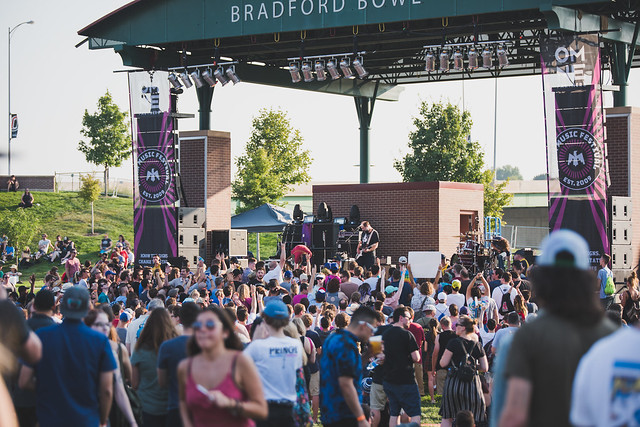

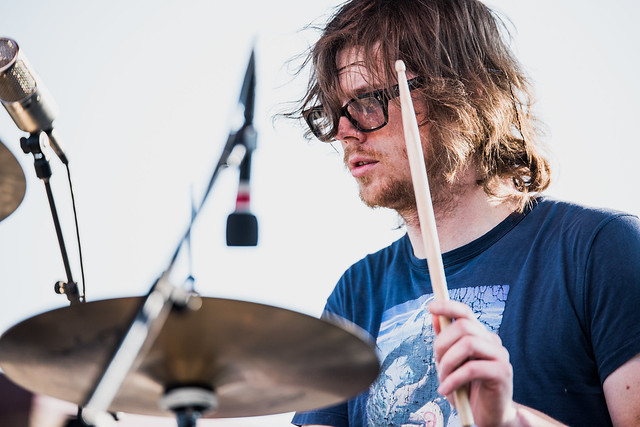
photos by Emma Petersen
Belle and Sebastian
By the end of the set, it felt fitting that members of the audience were invited from the crowd and led on stage to dance and sing along beside the members of Belle and Sebastian. As of seven o’clock when the Scottish indie band began on the main Maha stage, they were maybe the brightest, most dance-able, body-moving group of the day, and, reasonably, people certainly had been moving throughout the hour-long set.
At times folk-like and at times bubblegummy pop, Belle and Sebastian played an assortment of favorite tracks—all the way from “She’s Losing It,” a song off their debut 1996 LP, to “We Were Beautiful,” a more electronic-inspired single released just this year. With horn players and keys, a boppy bass guitar and acoustic strings ringing over all, the set was a variety pack of cool, jingling numbers, brought forth in an aura of positivity and optimism. In presence, leading man Stuart Murdoch matches well the spirit and thrust of the music—a warm, light-hearted nature, conversing and teasing, telling stories between songs and poking fun at the “crazy wall-building antics” of America’s president.
Omaha happened to be the last stop for Belle and Sebastian on what has been a month-long tour of the U.S.
It was for “The Boy With the Arab Strap,” a soft, clapping little track from their third album, that Murdoch began bringing up fans, who remained for the final three songs. The crowd, by this point in the night, filled most of the green space between the stage and the sound booths, and most clapped along too, and cheered for those who made it into the spotlights.
As the evening began to cool, Belle and Sebastian seemed to make sense in their slot: a soft prod to start grooving a little more, a pleasant warm up for the acts to follow—equally dancy, but gradually increasing in intensity.
—Nathan Sindelar

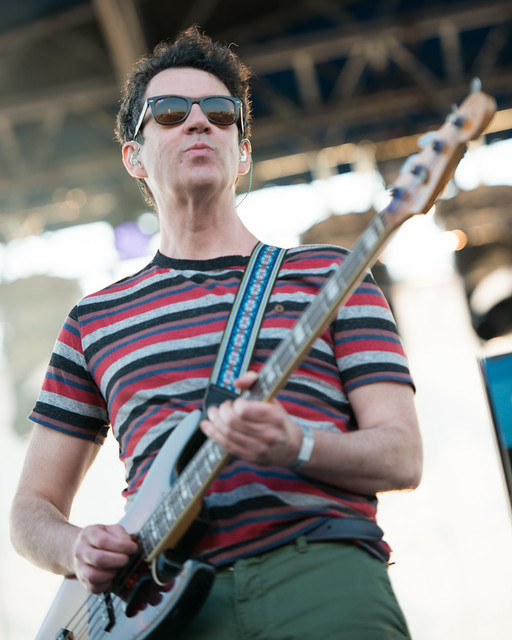


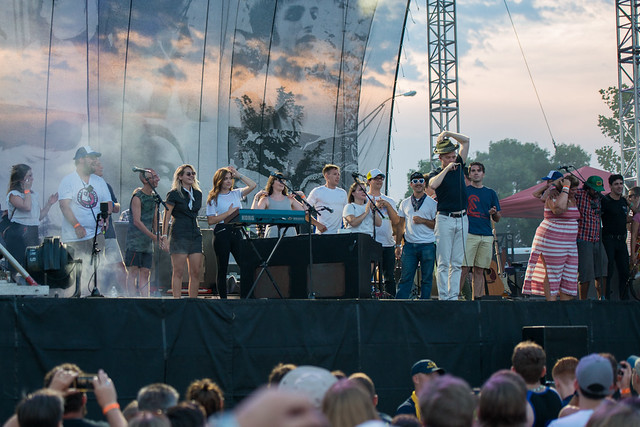
photos by Harrison Martin
Sleigh Bells
From the top of the smokers berm on the high hill closest to Center Street—the sun sunken far enough below the tree lines of West Omaha—Sleigh Bells was a perfect match for the first after-dark set of Maha 2017. Along with the crusted opening notes of distortion-heavy industrial pop, the set lights and fog machines of the Omne stage began their work for the night, as did the crowd (by this time a shifting, black lake stretching back toward the neon lights of the ferris wheel) and its glittering array of glow sticks and camera flashes.
In an hour-long set, the Brooklyn group — song-writer and guitarist Derek Miller, and vocalist Alexis Krauss — kicked off an onslaught of songs that oscillated between straight-up dance jams and moments maybe more befitting the headbanger’s ball.
The magic of Sleigh Bells’ performance is in the pop hook well-written, colored by and coupled with industrial beats and the sheer volume and intensity of the guitar riffs, the snap-crack-bass of the electric drums that one feels as much in their loose pant legs as their sternum.
Take “Infinity Guitars” or a song like “Crown On the Ground,” both of which featured in the performance, each immensely catchy, each nigh-blown out of comprehension with grainy distortion and haze. In another decade, one might’ve found Sleigh Bells in a warehouse rave. In 2017, the party’s out in the park.
—Nathan Sindelar

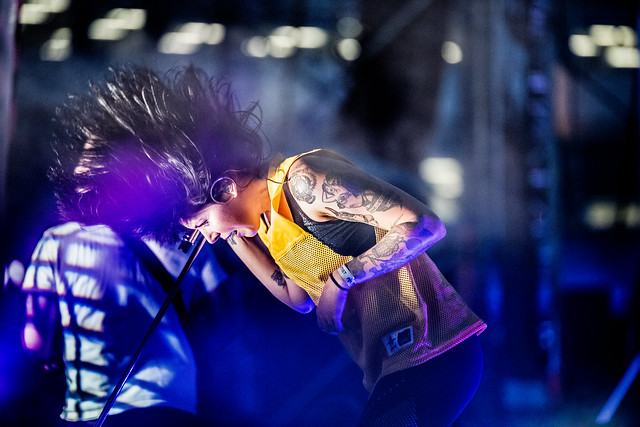
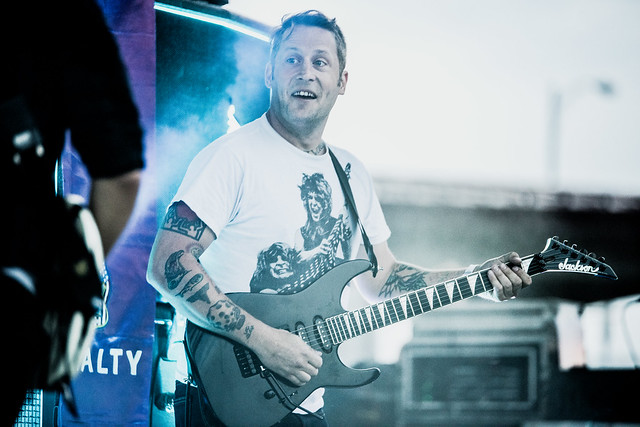
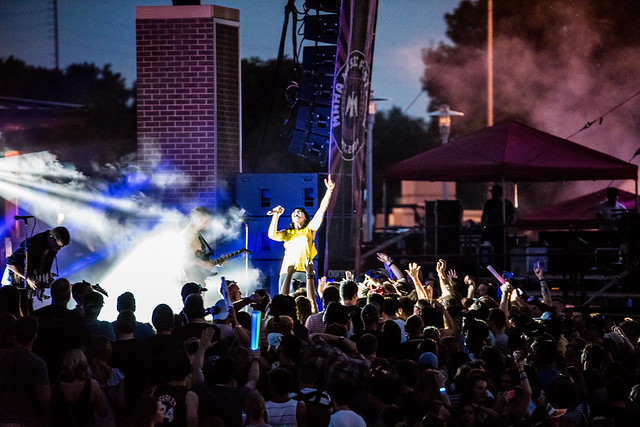

photos by Emma Petersen
The Faint
By the time The Faint and its crew appeared on the Weitz Stage to set up instruments and synthesizers galore, the moon had risen over Aksarben Village, illuminating hundreds of glow sticks as beach balls and balloons floated through the air. Maha’s largest crowd of 2017 yet pushed as close to the barrier as it could, but it still left enough room for one to needle through to the pit.
The P.A. music diminished, and The Faint emerged to start the Maha dance party. Purple and pink lights flashed as the band churned out hits like “Paranoiattack” and “Glass Danse,” with Fink erratically pulsating, like Thom Yorke on speed.
Near the end of “Skylab 1979” — a bonus track from the band’s retrospective CAPSULE: 1999-2016 — Dapose stabbed his guitar toward the sky and launched into a deafeningly rapid guitar solo. While Ulicny continued his synth fidgeting, Fink put his microphone to the side and retreated to his own synth to add to the now-texturally towering post-rock wall of party music. Even amidst the chaos of Clark Baechle’s driving bass and drum bouncing hi-hat cymbals, The Faint were more than just a dance band, but a dance band with nuance.
Crowds at other dance concerts might tire after a few songs, but The Faint kept them on their toes. Each verse and Fink’s esoteric, robotic vocals ticked like a bomb until exploding into twisting synths that forced the Maha crowd into hysteria. “Worked Up So Sexual” saw Fink repeatedly hopping up and down as the song’s hook neared, inciting his fans to mimic him.
Even at 43, Fink has the power to control thousands of people of all ages. Fink was the ringleader of bursts of energy through Stinson Park, and the audience was his legion of manically willing adherents.
—Sam Crisler
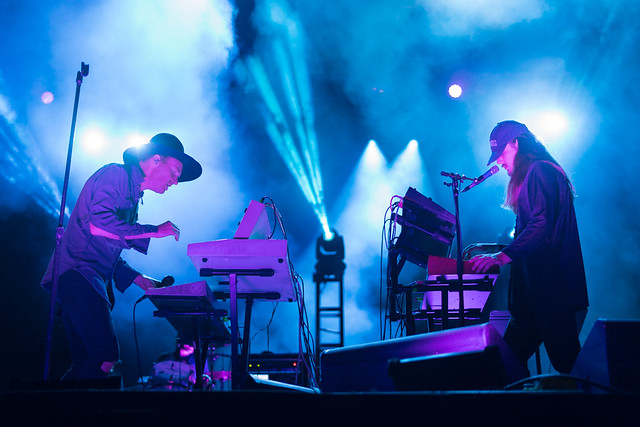
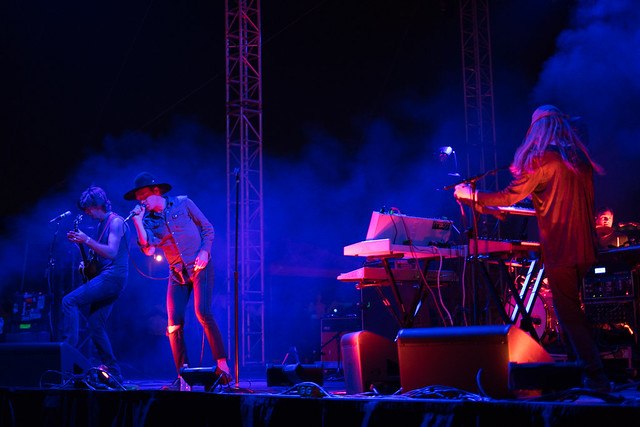
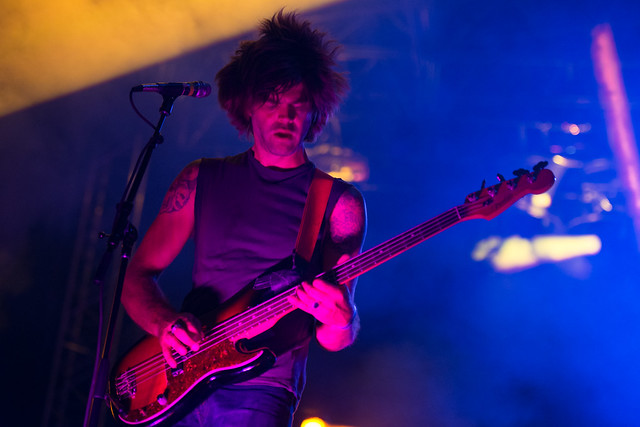
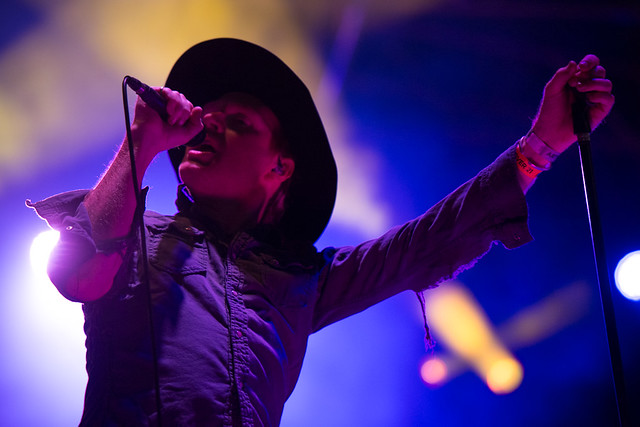
photos by Harrison Martin
Run The Jewels
Even before they stepped into view on the Weitz main stage (to a sing-along of “We Are the Champions” no less) the energy of the hip-hop duo Run the Jewels had long been coursing through the Maha 2017 crowd. It’s not unnatural to hear whispers throughout the day about the headliner of a festival, but the presence of RTJ in Omaha seemed to spark particular excitement in the more-than 8000 people who visited Stinson Park this year. By the time the group’s car-sized fist-and-gun emblems were raised above the set, no matter the song played during this setup phase, people in the crowd were singing, rapping along and dancing as vigorously as any had during all the previous live shows of the day—the way you salivate at the smell of food in the oven before you can even see it.
And then we did see it—El-P stepping out in black denim and shades, Killer Mike in all black with gold chain, about to roar into his mic, “Omaha, we came to fuck shit up.”
And the crowd goes…
Maha’s response seemed to come as a surprise to both Killer Mike and El-P. After lighting into the first couple tracks, El-P called out, “Who knew Omaha was so fucking lit?”
It only got more lit as the set went on. Bangers from RTJ albums 1, 2, and 3 all featured: “Oh My Darling Don’t Cry,” “Stay Gold,” “Lie, Cheat, Steal,” “Legend Has It.” Obviously, people love these songs, but in some ways it almost didn’t matter which track the duo picked and performed. There’s a draw to Run the Jewels that goes well beyond the craft of their music. There’s an energy between the two artists, their stage banter, their back-and-forth presence on the tracks and on the stage itself. As in the wont-back-down “Talk to Me,” Killer Mike takes a verse, El-P filling and accenting with shouts and repeating keys points. Then El-P takes the lead and the same thing follows vice versa.
In motion, it’s infectious. It got people jumping, rapping along, screaming in joy and support. Mid-set Killer Mike stopped between songs to say, in genuine awe, in reference to the thousands of faces looking up at him, “This is amazing.”
The act is certainly that, an act, performance art—and so affected to some degree certainly—but the live performance given tells the story of a healthy relationship as much as any other. A successful partnership, a collaboration, a friendship. It seems as much pleasure is taken in the instrumentals getting laid down by DJ Trackstar as in the spectacle of two people with undeniable chemistry operating at the peak of their powers. The assertion of self, the shared attitudes, the mutual confidence in those stances: Look at me, I’m here, I’m Okay, This Isn’t. Together Killer Mike and El-P rap in a dialogue, they rap as though they’re giving a communal lecture on nature of hype. They rap like two thrilled strangers who find out they’ve had the same dream.
And, lucky for everyone who stayed till the end of Saturday night in Stinson Park, now they have have too.
—Nathan Sindelar
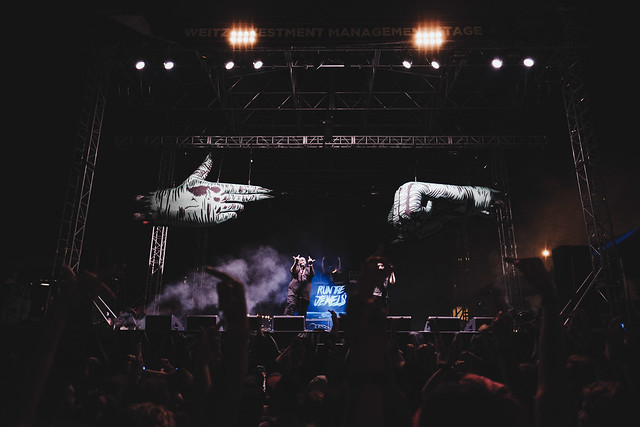
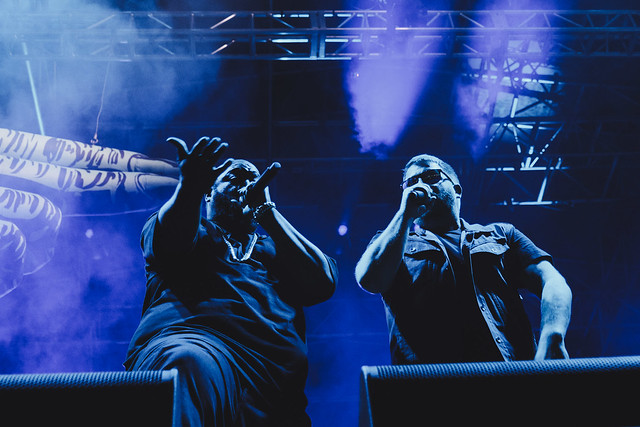
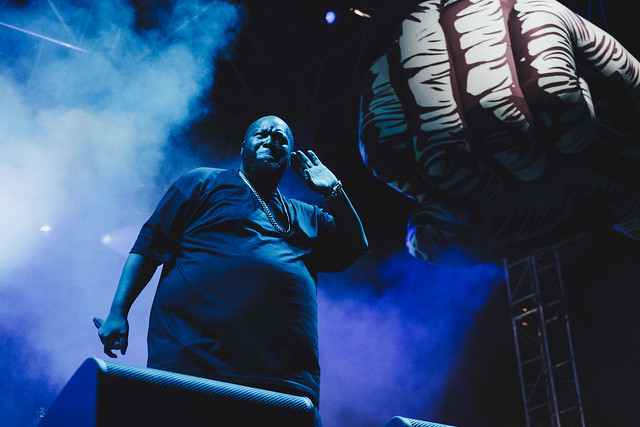

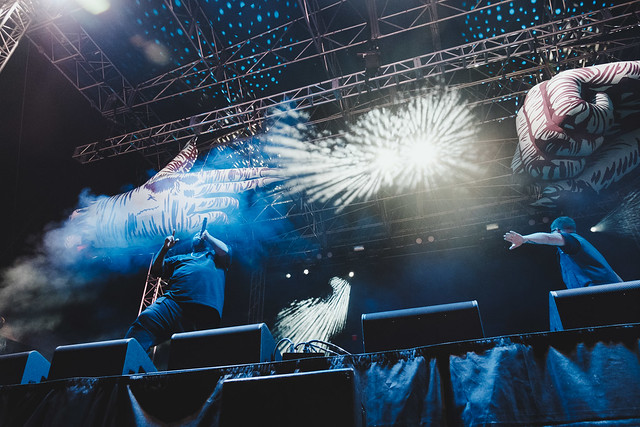

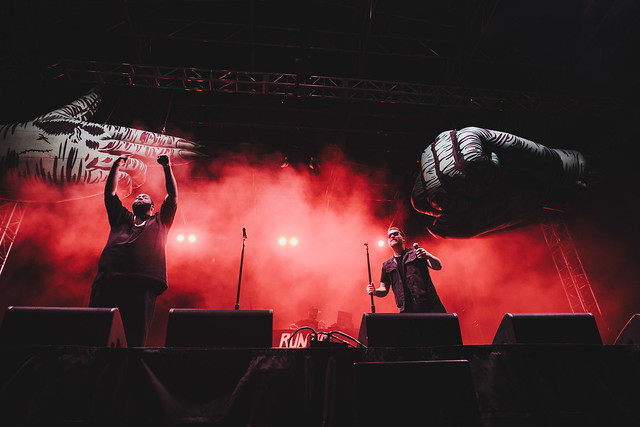
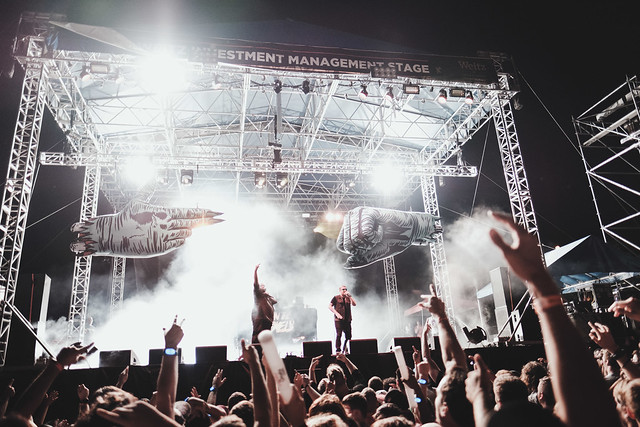
photos by Peter Barnes
More from Maha Music Festival
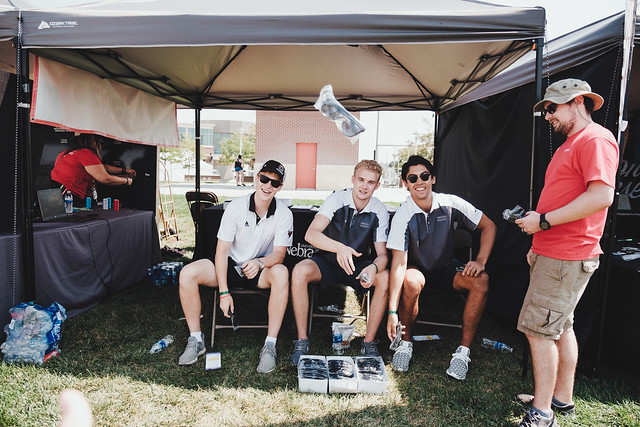
photo by Peter Barnes

photo by Peter Barnes
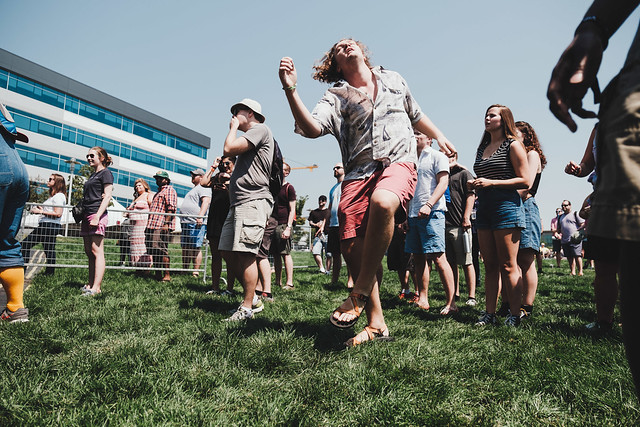
photo by Peter Barnes

photo by Peter Barnes
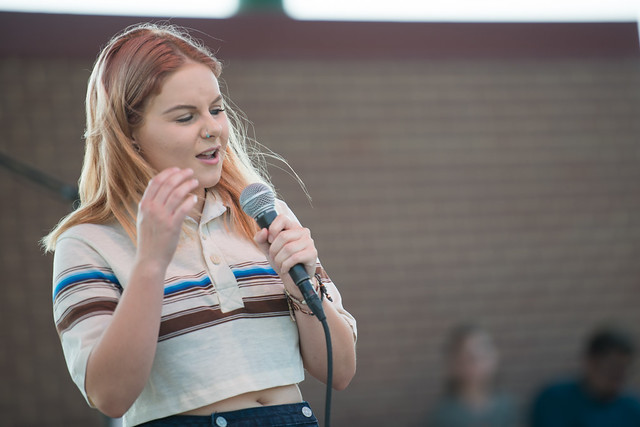
photo by Harrison Martin

photo by Peter Barnes
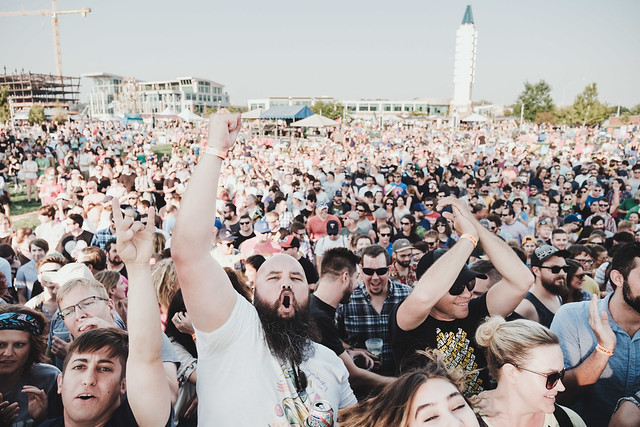
photo by Peter Barnes
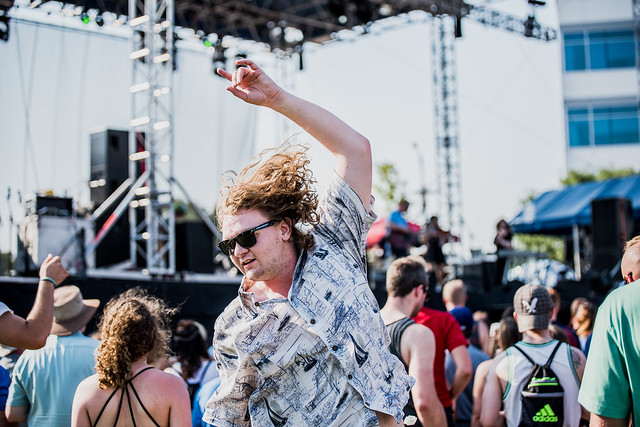
photo by Emma Petersen
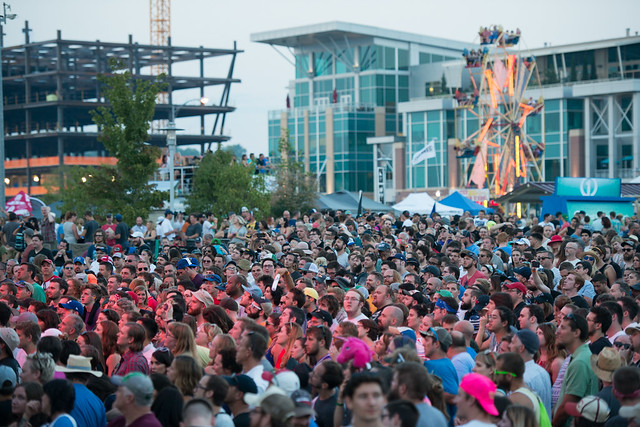
photo by Harrison Martin
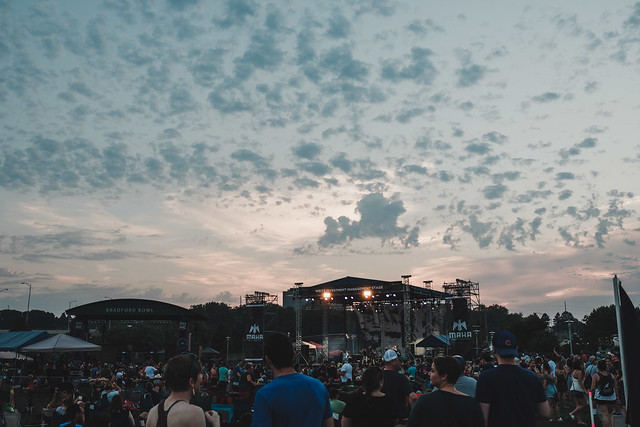
photo by Peter Barnes

photo by Harrison Martin
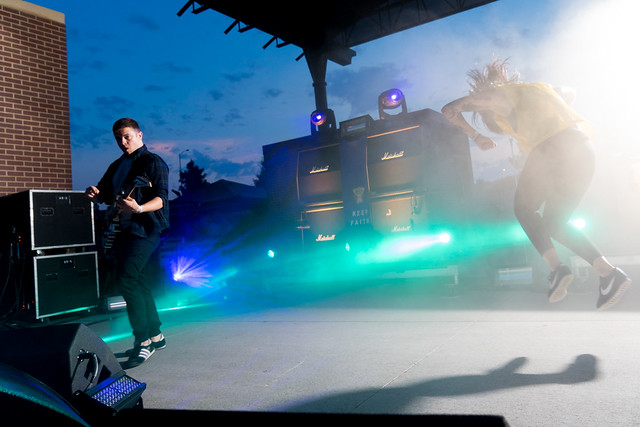
photo by Harrison Martin

photo by Harrison Martin




